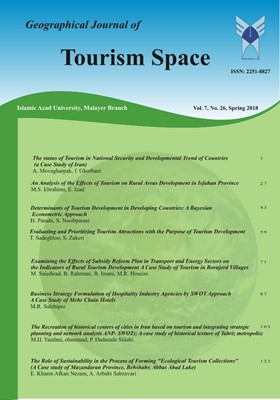Examining the Effects of Subsidy Reform Plan in Transport and Energy Sectors on the Indicators of Rural Tourism Development A Case Study of Tourism in Borujerd Villages
Subject Areas :
majid saeidirad
1
,
Bahram Imani
2
,
Bizhan Rahmani
3
,
df bdf
4
![]()
1 - sbu
2 - ; the faculty member of Mohaqeq Ardabili University, geography, urban, and rural planning department, Ardabil, Iran
3 - The faculty member of Shahid Beheshti University, Human geography and planning department, Tehran, Iran
4 - df
Keywords: Transportation, Borujerd, Rural tourism, reform subsidies plan,
Abstract :
By implementing the historical transformation of the subsidy reform plan in 2010, the economic operation of the era of transition from a subsidized economy to a competitive and free one took place after two decades of waiting, and the studies on this issue from the perspective of monitoring and evaluating post-implementation effects entered a new field. As the reform subsidy plan in the transportation and energy sectors is the first priority of the government's economic development agenda, the implementation of this plan has affected rural housing as well as other sectors of its policies. In the present study, an attempt is made to examine the effects of reform subsidies in the transport and energy sectors on rural tourism development indicators in Borujerd, as an "assessment during implementation". The research is an applied one and its method is descriptive-analytical. The data gathering method was library and field analysis. The data were analyzed using descriptive statistics and inferential statistics (Kendall's tau-b,Spearman and multiple regression). Finally, the results indicated that there was a significant relationship between the reform subsidies indicators and rural tourism indicators. Therefore, the promotion of the reform subsidies indicators to achieve rural tourism development is one of the effective strategies that should be focused by the government authorities more than before.
10- Adorno, V. Bernini, C. Pellegrini, G. Do Capital Subsidies Affect Growth in the Tourism Industry?.
11- Blake, A .,& Sinclai, M. (2003). TOURISM CRISIS MANAGEMENT: US Response to September 11,Annals of Tourism Research, Volume 30, Issue 4, , Pages 813–832
12- Dorward, A., Chirwa, E., Boughton, D., Crawford, E., Jayne, T., Slater, R.,... & Tsoka, M. (2008). Towards ‘smart’subsidies in agriculture? Lessons in recent experience in Malawi. Natural resources perspectives. 116.
13- EZEUDUJI, I. O. (2015). Building capabilities for sub-Saharan Africa’s rural tourism services performance. African Journal for Physical Health Education, Recreation and Dance: Supplement 1, 21, 68-75.
14- Fleischer, A .,&Felsenstein, D. (2000). Support for rural tourism: Does it make a difference? ,Annals of Tourism Research, Volume 27, Issue 4, Pages 1007–1024.
15- Kothari, C.R. (2009). Research methodology, method and techniques (Second Revised Edition), New Age International Publishers. New Delhi: 1-401
16- OECD.(2005). Subsidy Reform and Sustainable Development; Economic, Environmental and social aspects.
17- Sirvavastave, D.k., C.Bhujanga Rao. (2003). Governments Subsidies in India Issues and Approach, National Institute for Public Finance and Policy.
18- Schubert, S. F.,& Gabriel Brida, J. (2008). Dynamic effects of subsidizing the tourism sector. Tourism Economics, 14(1), 57-80.
19- Tabor, S. R. (2002). Assisting the poor with cash: Design and implementation of social transfer programs. World Bank Social Protection Discussion Paper, 223.
20- Vrhovski, D. Földing, B., & Prebanic, S. (2014). Government subsidies efficiency analysis in the tourism sector in Croatia. In Faculty of Tourism and Hospitality Management in Opatija. Biennial International Congress. Tourism & Hospitality Industry (p. 161). University of Rijeka.
_||_

